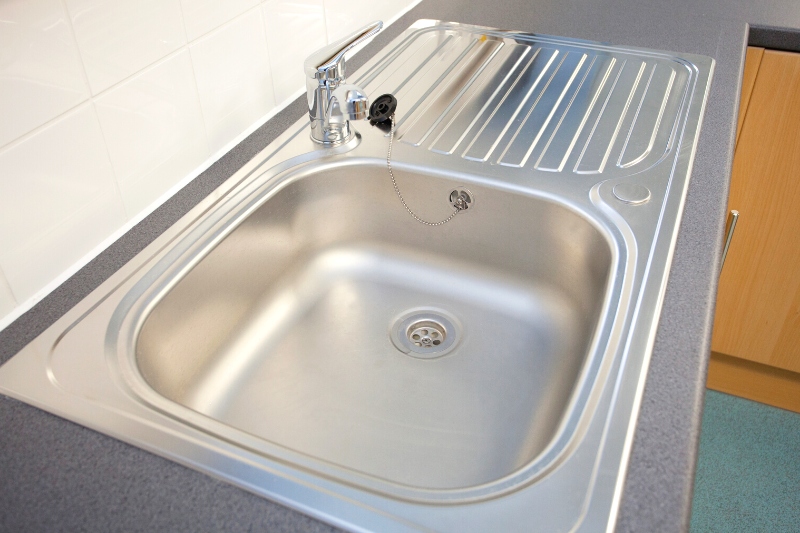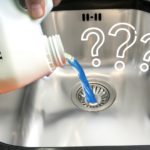Stainless steel sinks are one of the most popular choices in modern kitchens. Not only do they look sleek and stylish, but they’re also reasonably cheap, extremely durable, and rust-resistant.
Unfortunately, their shiny finish also means they’re prone to collecting fingerprints and water marks.
If left to build up, these markings will cause the stainless steel to appear dull and cloudy, so cleaning your sink regularly is essential to keep it in tip-top condition.
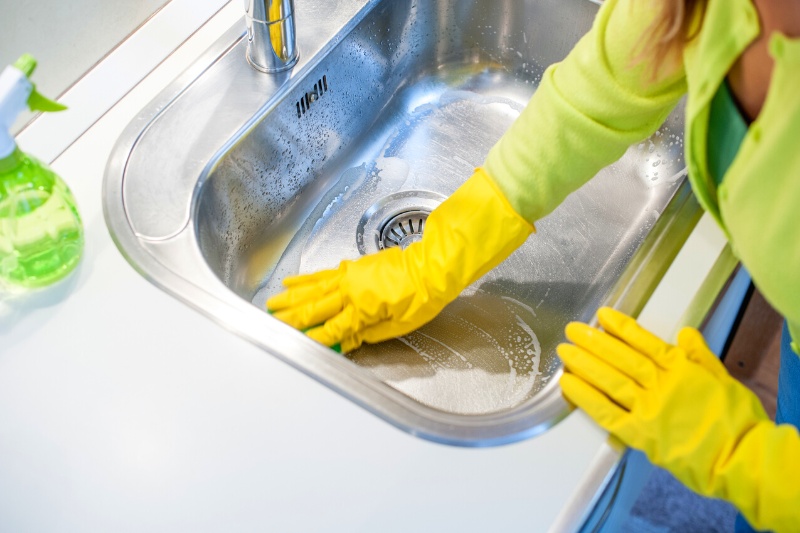
Thankfully, stainless steel is easy to clean when you know the proper method. All you need is a few kitchen cupboard essentials and a bit of time.
Without regular maintenance, it is not uncommon for stainless steel sinks to accumulate unwanted limescale deposits, stains, and other types of grime. However, it is possible to restore your sink back to its original condition!
In this article, we explore how to clean a stainless steel sink and discuss some of the reasons your sink may have lost its shine. Keep reading for all the info!
What’s the Best Cleaner for a Stainless Steel Sink?
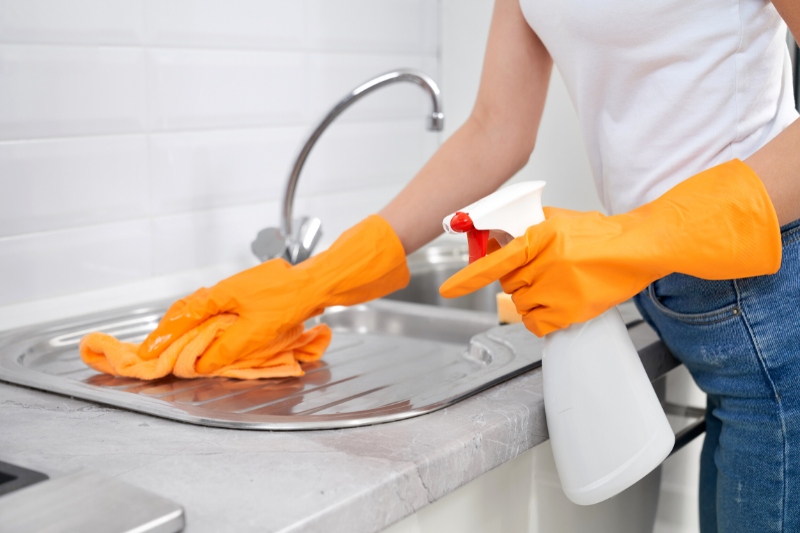
Stainless steel is a durable material that can withstand strong cleaning products. However, some clearers will damage the surface of your sink (explained below).
To avoid damage but still achieve an effective clean, we recommend using the following natural ingredients, many of which you’ll already have in your home:
- Bicarbonate of soda
- A lemon or lime
- Distilled white vinegar
- Olive oil
- Microfibre cloths
- A non-abrasive sponge
- A spray bottle
Method for Cleaning a Stainless Steel Sink
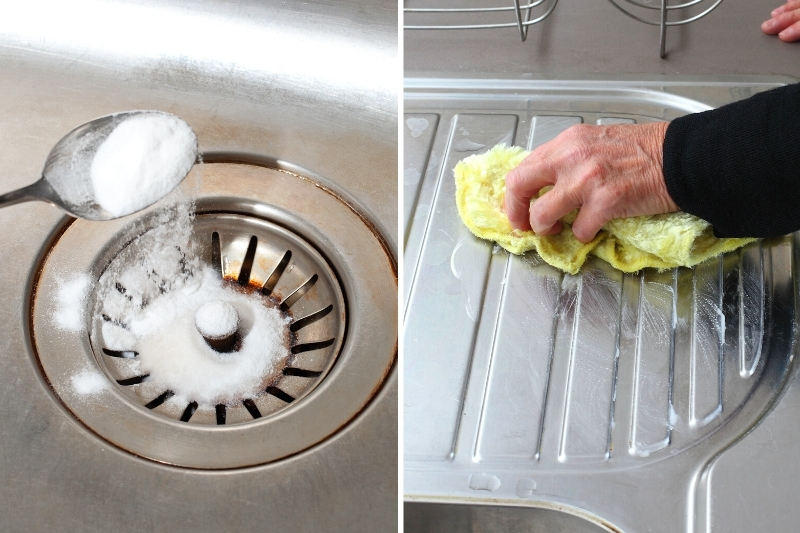
Once you have the above list of ingredients, follow the method below for the best results. Using this process, you can cut through unsightly stains and give your stainless steel sink a shiny mirror finish. It will look as good as new!
- Use clean, hot water to rinse any loose debris from your sink.
- Sprinkle a thin layer of bicarbonate of soda over the damp surface, ensuring you don’t forget the sides and draining board (if applicable).
- Gently scrub at the bicarbonate with a damp sponge, paying particular attention to any dirty areas. The aim is to create a mildly abrasive paste, so feel free to add more water to your sponge if needed.
- Cut your lemon or lime in half and use the exposed area to scrub over the bicarbonate paste still coating your sink.
- Rinse away any remaining paste with hot water.
- If any limescale patches remain, spray a 1:1 solution of distilled white vinegar and water over the affected areas using a spray bottle.
- Use your sponge to scrub at the hard water stains, and then rinse away any residue.
- Dry your stainless steel sink with a microfibre cloth to prevent future water stains.
- With a new microfibre cloth, buff a little olive oil into the surface of your sink, ensuring you work in the direction of the grain.
- Wipe off any excess oil and admire the shiny, clean surface—it’ll look brand new!
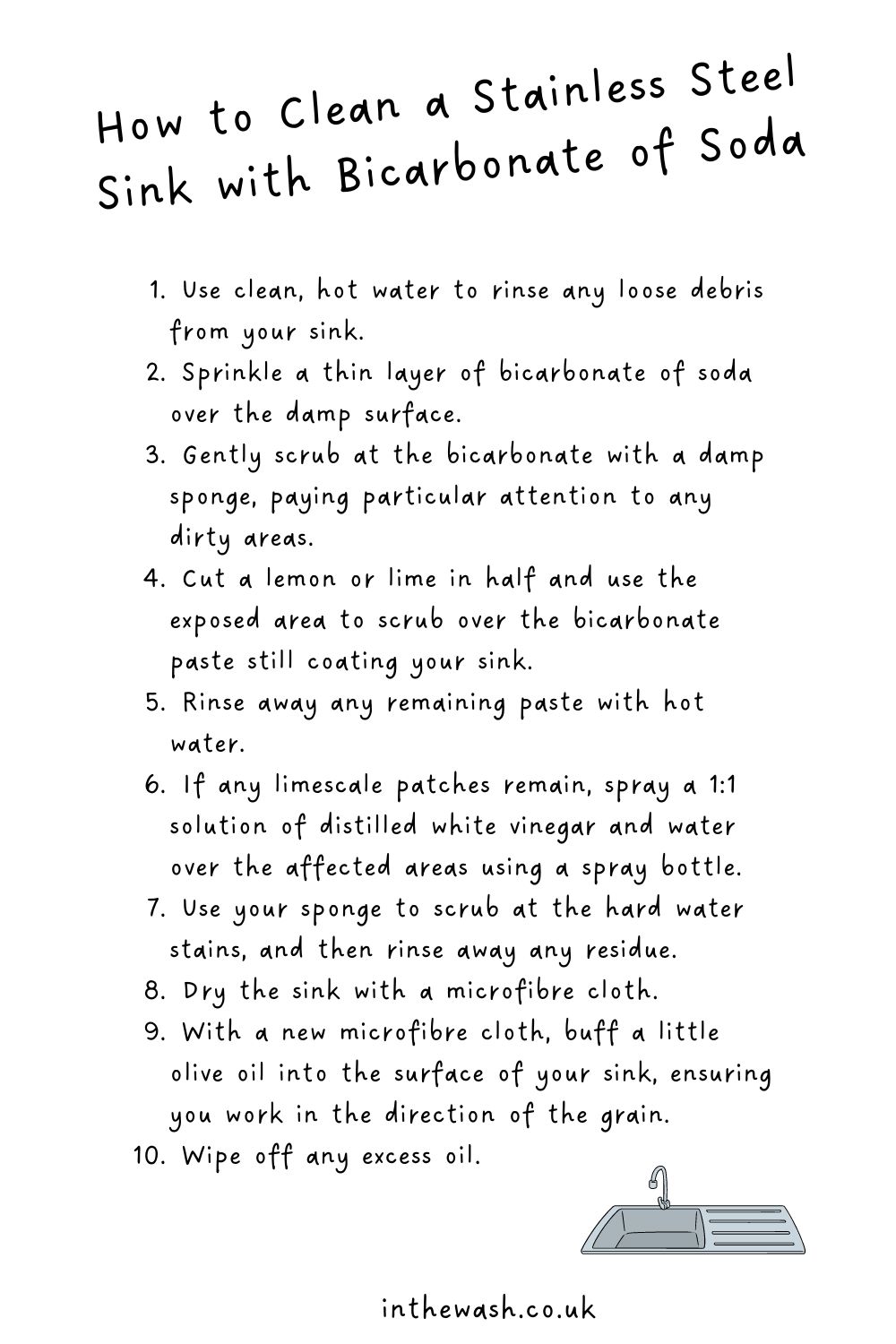
Alternative Methods for Cleaning Stainless Steel
While we recommend using the above method when cleaning a stainless steel sink, a variety of other cleaners can also be used to great effect.
A few of these are already used in our preferred method, but they can also be used on their own if you don’t have all the ingredients to hand.
Some of your best choices are:
Commercial stainless steel cleaners
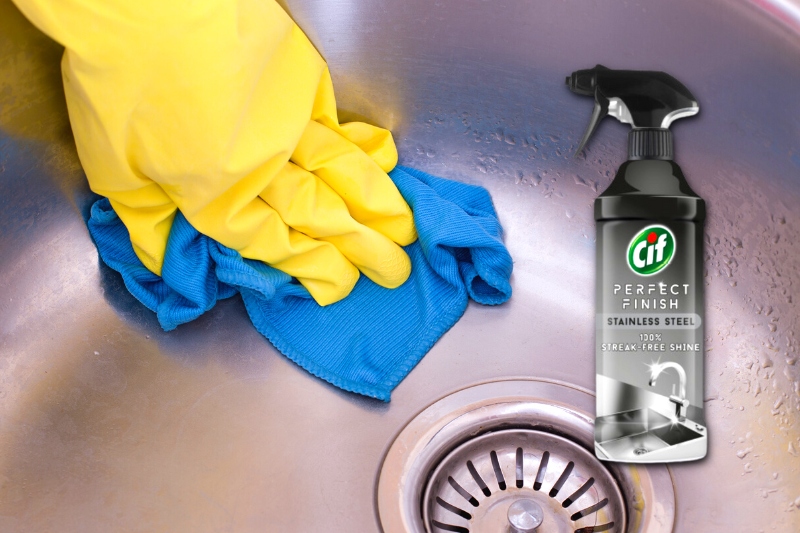
Loads of commercial cleaners are available to buy that are designed for use on stainless steel. The chemicals used in these products typically make them very good at removing any tough stains and limescale.
According to The Express, Cif’s Perfect Finish Stainless Steel Cleaner is a great choice if you’re unsure where to start.
Washing-up liquid
If you want to give your sink a quick clean, we recommend using washing-up liquid. You can simply apply a little to a damp sponge and use it to scrub the whole sink before rinsing it away.
This is great for quickly refreshing the surface but won’t do much if you’re working with stains or limescale.
Bicarbonate of soda
Bicarbonate of soda is a natural deodoriser and mildly abrasive, making it great for removing stains. When combined with a bit of water, a cleaning paste will form that can be gently scrubbed over your sink before rinsing it away.
Lemon juice and bicarbonate of soda
Bicarbonate of soda can also be combined with lemon juice to increase its cleaning power and leave your sink smelling clean and fresh.
Simply cut a lemon in half, sprinkle the exposed area with some bicarbonate, and then use the lemon to scrub the sink. Rinse thoroughly with warm water to remove all the residue.
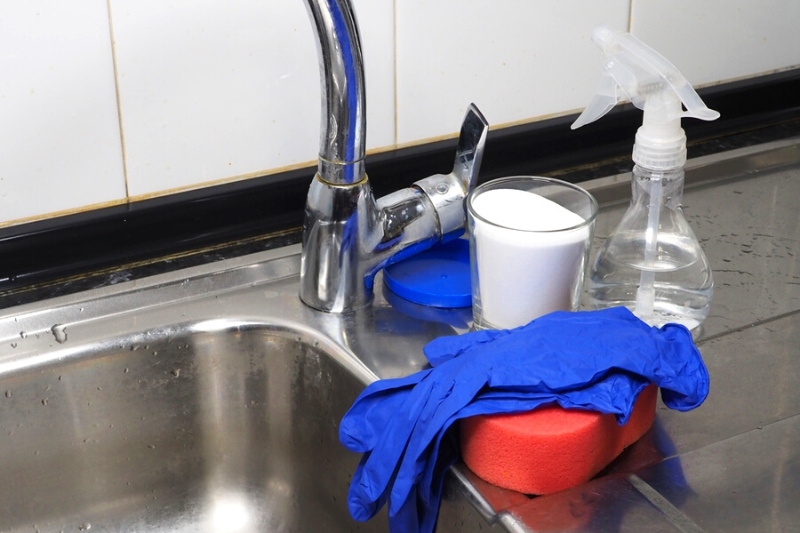
Distilled white vinegar
A mildly acidic cleaning solution is formed when you combine a 1:1 solution of distilled white vinegar and water. This is particularly effective at removing hard water stains and unpleasant smells.
Once sprayed onto your sink, leave it to sit for a few minutes, and then rinse thoroughly.
Ash from your fireplace
It may sound a bit unconventional, but ash from your fireplace can also be used to disinfect stainless steel and remove stubborn dirt.
You will need to combine it with a little water to form a paste that can be scrubbed all over your sink. Rinse thoroughly and repeat if necessary.
What Should You Not Use on Stainless Steel?
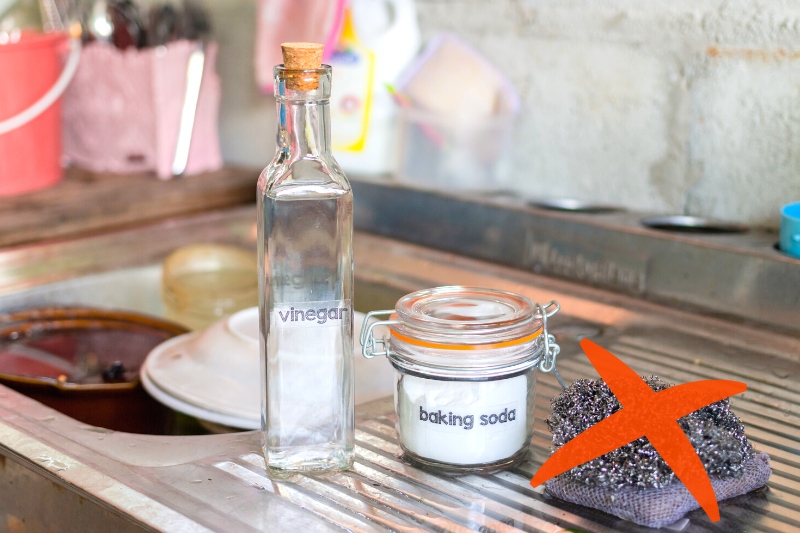
Stainless steel is a very durable material, but there are still some definite no’s when it comes to cleaning it.
Below are the two main things you need to avoid when cleaning your sink in order to prevent any accidental damage:
Strong chemical cleaners
Products containing harsh chemicals, such as chlorine bleach and oven cleaners, can strip the protective barrier from your sink, making it much less durable. Once this has occurred, they can also leave etchings in the metal.
Abrasive scrubbers
Abrasive scrubbers, such as steel wool and coarse sponges, can also cause irreparable damage to the coating on your sink. This will leave behind scratch marks and make the surface look dull.
When steel wool is used, there is also the possibility of particles being left behind, which will later turn into unsightly rust.
Why Does My Stainless Steel Sink Always Look Dirty?
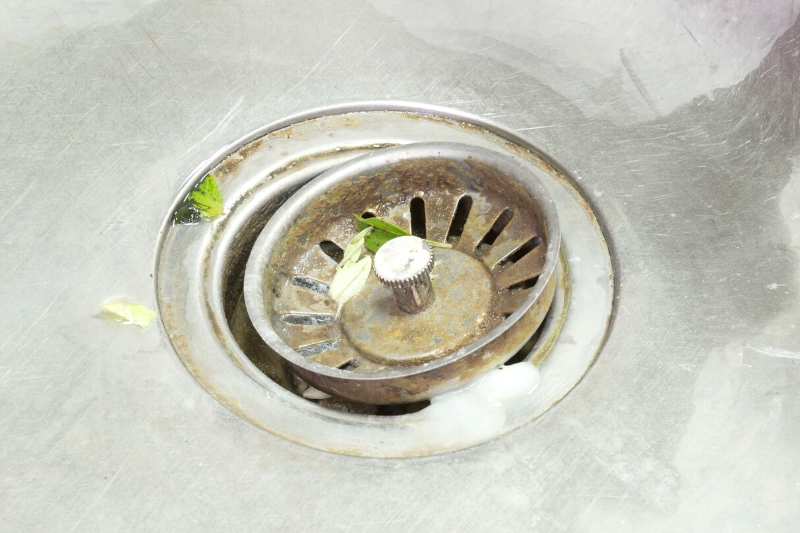
With the proper care and maintenance, a stainless steel sink will continue to look shiny and new, even after years of use.
However, they can become cloudy and dull over time if not cared for. This will cause your sink to appear dirty, even after a quick maintenance clean.
There are three main causes of this, each of which is covered below.
Hard water stains
If you live in a hard water area, you’ll be no stranger to the annoying limescale deposits. Unfortunately, one of the main places where this build-up occurs is in your kitchen sink.
Limescale is notoriously tricky to remove, especially if it has been left to sit for a long time. As these mineral deposits slowly accumulate, your sink will start to appear cloudy and will remain so until the deposits have been removed.
As mentioned, some of the best ingredients for removing these hard water stains are distilled white vinegar and lemon juice.
However, if you’re looking for a more long-term solution, you can purchase a water softener to remove any minerals from your water supply before they reach your sink.
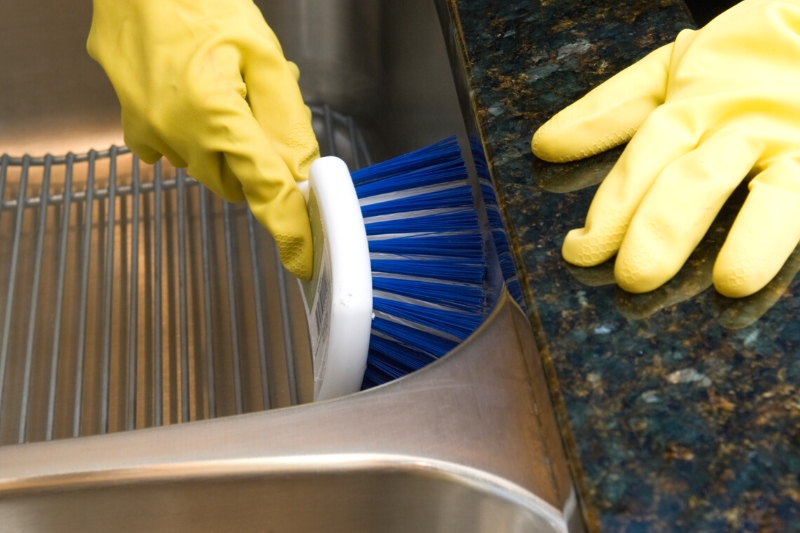
Etching in the stainless steel
When you find a particularly stubborn stain in your sink, it’s natural to reach for your strongest cleaner. Unfortunately, this often includes the use of harsh chemicals and overly abrasive scrubbers.
As we have seen, both of these items need to be avoided when cleaning stainless steel. This is because they will damage the protective barrier on your sink and leave behind noticeable scratches. Both of these will make the metal appear cloudy and dull.
No matter how badly stained your sink is, it’s always best to stick with mild cleaners and non-abrasive scrubbers, such as those mentioned above.
Also, try to scrub in the direction of the grain when cleaning, as this will further reduce the chances of scratching and help to remove any dirt from the tiny grooves.
Starchy residues
The last thing that could be causing your stainless steel sink to appear dirty is starchy residues. Although foods like potatoes, rice, and pasta taste delicious, they contain high levels of starch that will stick to your sink when you’re doing the dishes.
If this residue is allowed to build up, it will form a cloudy layer in your sink and take away the shine from the stainless steel. Fortunately, this starchy residue can easily be removed using a little white vinegar and water—your sink will have a mirror shine again in no time.
How to Clean a Stainless Steel Sink Without Scratching It
Anything harsh and abrasive can scratch the surface which is designed to be mirror-smooth and shiny.
Any scratches or dents can serve as a home to bacteria and grime and will dull the shine of the steel so it is best to keep scouring products away from the sink. Instead, choose a soft cloth and gentler products.
There are plenty of products on the market designed specifically for stainless steel and you will want something that will cut grease without containing heavy abrasive chemicals.
Simple washing up liquid can cut the grease but you will want to use a disinfectant to kill any lingering bacteria, particularly around the taps and plug hole.
Spray the disinfectant liberally over the stainless steel surface, including taps and plughole, and leave to stand for a minute or two. Take your soft cloth, wet it and wipe the disinfectant away, rinsing as you work.
If you leave the sink wet, it will dry with watermarks and won’t look clean so it’s always best to dry the surface after with a soft dry cloth.
If you want to leave your sink shining like new, then you will need to give it a polish with something that is safe to use around food. White vinegar is a firm favourite as is lemon oil and even olive oil gets good results.
You can decant some white vinegar into a spray bottle and mix half and half with water and then spray over the surface. Taking your soft cloth you can then buff the surface, wiping over the whole area until you have removed any watermarks or dull areas.
White vinegar is also a natural anti-bacterial so it will help to keep the sink free from harmful bacteria. The sink should be shining like new.
Using lemon oil will give you a pleasant fresh citrus scent and this is sometimes preferred over the mild scent of vinegar, and lemon oil also has some anti-bacterial properties.
These products are inexpensive and can help you to keep your kitchen shining like new for years to come.

Hannah has a passion for cleaning. She worked her way around Australia by cleaning hostels in exchange for free accommodation and used her cleaning skills to bag a job as a chalet host for a luxury ski company in France.
